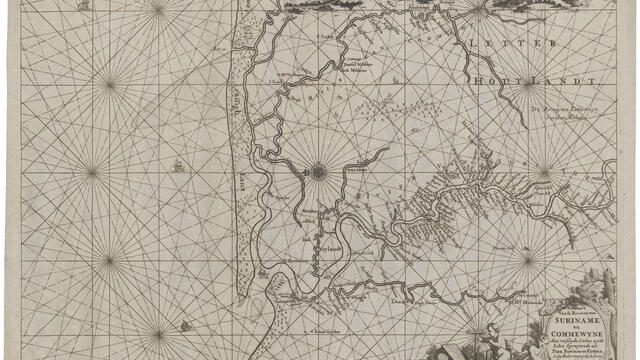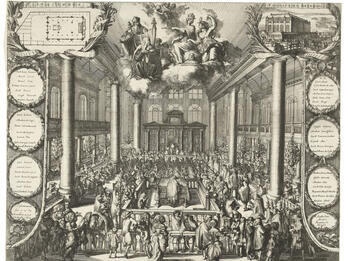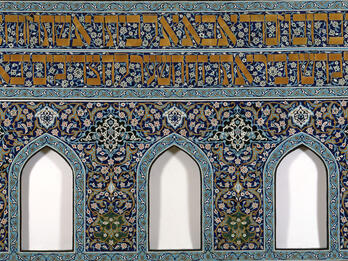Jews on the Move: Jewish Migration from 1500 to 1750
The geography of Jewish settlement shifted dramatically in the early modern period.

Jews were migrating across the world. Despite many lines of continuity with the medieval period, from the fifteenth century on, Jewish life took place in entirely new areas of residence, sometimes even in places where Jews had never before settled. At the same time, some countries that had been home to Jewish communities for centuries were no longer hospitable to Jews at all.
A New Map of Europe
Were we able to return to Europe at the start of the sixteenth century, it would be clear to us that the map of Jewish settlement had changed beyond recognition. Over the course of the medieval period, some of the largest Jewish centers had died out and lost their Jewish inhabitants. At the beginning of our period, Western Europe, in fact, had been almost completely emptied of Jews. Thousands of Jews had been expelled from England (1290) and France (1394), and the fifteenth century saw the Jewish presence in Castile, Aragon, Portugal, and Navarre eradicated; those who did not leave converted to Catholicism. Because Sicily and Sardinia were under Spanish rule, the Jews there were also forced to convert or leave. The Jews of Provence were expelled in 1501, and a wave of riots against the Jews of Naples, which began in 1495 following the French conquest, ended only in 1541, when the last Jews were forced to depart.
Similarly, in the 1390s, an unbroken wave of expulsion from German states began, continuing throughout the fifteenth century: from Vienna and Linz in 1421, from Cologne in 1424, from Speyer in 1435, from Mainz in 1438, and from Augsburg in 1439. These were followed by expulsion from Sweden and Franconia. The expulsion from Geneva took place in 1490, and from the duchies of Mecklenburg-Pomerania in 1492, from Halle and Magdeburg in 1493, from Württemberg and the archdiocese of Salzburg in 1498, from Nuremberg and Ulm in the following year. The Jews were expelled from Regensburg in 1519. After the rise of Luther and the wars between Protestants and Catholics, the wave of expulsions from German states and cities accelerated. In 1537, the Jews were expelled from Saxony; in the 1540s they were expelled from Zwickau and Mühlhausen; and from the Duchies of Brunswick, Hanover, and Lüneburg in 1553.
Recent research has shown that the expulsion of the Jews from the cities of Germany did not always and everywhere lead to their absolute removal from German territory. Jews driven out of cities frequently settled in villages close to the urban centers from which they had been expelled. This enabled them to maintain active commercial connections with the Christian population of the cities. For their part, in many cases the Christian burghers continued to make use of the financial services provided by Jews. Sometimes these expelled Jews formed small rural communities made up of Jews from various villages; they pooled their resources and developed new models for maintaining Jewish religious rituals, especially in connection with prayer and burial. These village Jews retained connections with the governments and residents of cities. In Strasbourg, for example, Jews of the surrounding rural area stayed associated with the Christian burghers, in commerce, in moneylending, and sometimes even as physicians. The expelled communities of German Jewry who did leave German territory did not disappear either. Instead, they moved to new areas, first constituting a small and relatively modest Ashkenazic community in northern Italy—mainly in areas where Jews had not previously lived—and then a large and eventually exceedingly important center in the Polish-Lithuanian Commonwealth.
In the words of a colophon of a short chronicle of the Jews of Germany, written by an Ashkenazic Jew who settled in Senigalia, Italy, “There was no disaster after [the Black Plague of 1349] in Ashkenaz until this day, the year 1485. Indeed, there were many expulsions. Blessed be He who changes the times.”1 Unlike previous centuries, when Christians rioted against the Jews of Germany and murdered them, now, according to this contemporary testimony, they only expelled, and expelled again. But the wave of expulsions did not affect only Jews who lived in German states. In the late medieval period, tens of thousands of Jews were forced to migrate from west to east, from Iberia to Italy, the Ottoman Empire, and North Africa, and from Germany to Poland and Lithuania. “Blessed be He who changes the times,” wrote the Ashkenazic Jewish chronicler.
Between 1500 and 1648, the number of Jews in Eastern Europe grew at a rapid pace, for the most part because of Jewish migration from the cities of Germany, including refugees who fled during the Thirty Years’ War (1618–1648). They played a key role in colonizing the eastern parts of the Polish kingdom, and in founding new cities and augmenting the population of existing ones in whose reorganization they participated. After settling in existing cities, they moved on toward the eastern regions and ultimately formed new communities in the Grand Duchy of Lithuania.
At the beginning of our period, the Jewish population of the Polish-Lithuanian Commonwealth was between 10,000 and 30,000 at most; by the time of the Khmel’nyts’kyi pogroms (during the war between Poland and the Cossacks), it is thought to have been between 200,000 and 450,000. Before 1500, there were only about 50 Jewish communities in Poland, and another 4 in Lithuania. Sixty years later, there were 173 in Poland and in Lithuania nearly 20. After the unification of Poland and Lithuania in 1569, Jews from the cities of northwestern Poland increasingly migrated southeastward, leading to a significant rise in the Jewish population on both banks of the Dnieper River. Dozens of new Jewish communities were established in Ukraine between 1569 and 1648. Before the unification with Poland, there were only 24 Jewish settlements in Ukraine, with a combined population of 4,000. Toward the mid-seventeenth century, there were already 115 communities in that region, with more than 51,000 Jews.
As a result of the Cossack revolt (1648–1649), the Swedish invasions of Poland during the Second Northern War (1655–1660), and the war between Russia and Poland (1654–1667), which sowed destruction in many Jewish communities, for a short while Jews migrated out of the region, to Hungary in the south and to Holland, Italy, and the German states in the west. However, before long the direction of the migration from east to west reverted to what it had been before the pogroms, and at an even larger scale, as many of the emigrants returned to their earlier homes. Toward the mid-eighteenth century, most Jews in Ukraine lived in towns owned by Polish aristocrats, and in 1764, more than 70 percent of the Jewish population of Poland lived in the eastern regions of the kingdom.
Jewish Migration in the Ottoman Empire
At the same time that Jews were being forced to migrate from the Christian countries of Europe, they were being forced to migrate within the Ottoman Empire. By order of the sultan, beginning three years after the conquest of Constantinople (Istanbul) in 1453, dozens of Jewish communities in areas already conquered by the Ottomans were ordered to resettle in the imperial capital. This strategy of forced migration of populations, called sürgün, was standard policy for the Ottoman sultans in the period.
These expulsions and forced migrations must be seen against a broader background. In the medieval period, Jews were expelled from various countries while Christians were not. In the early modern period, however, Jews were not the only ones compelled to migrate because of religious persecution; the issue of refugees and religious persecution was common to the history of many ethnic and religious groups in the early modern period. Diverse religious minorities became refugees, not only in Europe but on other continents as well. The historian Heinz Schilling defined this as “confessional migration,”2 and Nicholas Terpstra has pointed out that the “language of purification and purgation came out of medicine, but was adopted by religious reform movements. The drive to purge and purify reshaped Europe and the globe throughout the early modern period.”3 The impetus to purify cities and entire states from the “polluting” presence of the threatening religious adversary, according to Terpstra, is one of the outstanding characteristics of the history of the sixteenth and seventeenth centuries.
Refugees from religious persecution were a common sight throughout this period. After the conquest of Constantinople, thousands of Christian Greeks fled to the West, and in 1502, shortly after the expulsion of the Jews from Spain and Portugal, about half a million Muslims were expelled from Castile, and later from Valencia and Aragon as well. Catholics fled from Protestant countries such as England, Scotland, Sweden, and the new Dutch Republic. Conversely, Protestants abandoned countries that remained loyal to the Catholic Church such as Italy and Spain. Italian Protestants of various denominations fled from the threat of the Roman Inquisition in Italy to Switzerland, England, Germany, Transylvania, and Poland. Similarly, between 1567 and 1573, tens of thousands of Protestants fled the southern Netherlands, escaping the iron fist of the Duke of Alba. Nearly 150,000 were driven out of Antwerp when the Spanish army conquered it. On the other side, thousands of Catholics fled from the northern provinces, which swore allegiance to the Calvinist faith. The Moravian Brethren were forced to go underground after their defeat in the Battle of the White Mountain in 1620, and many of them dispersed throughout northern Europe and the Netherlands. And French Calvinists, known as Huguenots, undoubtedly the largest and most prominent group of refugees of that time, fled to Geneva, England, and Holland after the massacre in Paris in 1598. Toward the end of the seventeenth century, renewed persecution drove nearly 150,000 of them into exile.
Religious refugees reached Asia, Africa, and the Americas, Mexico and Peru, India and China. Jewish refugees too reached every corner of the earth, sometimes in the guise of a New Christian (Iberian Christians of Jewish origin) or Marrano (Iberian Christians of Jewish origin who retained some Jewish practice in secret). These Jewish exiles, dispersed in many countries on several continents, encountered (and were encountered by) Protestants and Catholics, Moravian Brethren and Socinians (an anti-Trinitarian heresy), Quakers and Huguenots. Their interactions enriched Jewish and European culture in many respects, influenced the formation of Christian Hebraism, aroused vital theological disputes, and even, in some cases, led to productive cooperation between Christians and Jews in advancing shared cultural projects.
Because of these complex processes and phenomena, which transcended the boundaries of individual nations, this period not only differed significantly from the previous one but also was perhaps even unique.
Over the sixteenth century, the Ottoman Empire absorbed thousands of Jewish immigrants from various backgrounds. Ottoman censuses (for taxation) show a swift increase in the first third of the sixteenth century, when the refugees from Spain first appeared. As many as 50,000 Jews from the Iberian Peninsula may have arrived in the Ottoman Empire between 1492 and 1510. In the port city of Salonika, where no Jews had lived before, their number may have been about 17,000 in 1519, and by 1535, Istanbul was home to as many as 40,000 Jews. One needs to be cautious with these figures, however, as there is no way of fixing a precise number for these urban populations. In any case, the population, both Jewish and non-Jewish, fluctuated over the centuries, if only because of the regularly recurring—and quite deadly—outbreaks of the plague. This caveat aside, in some cities, like Salonika and Safed (with a Jewish population of a few thousand), Sephardic Jews actually formed the majority of the total urban population; in most cities around the world, they constituted less than 10 percent. Salonika and Istanbul would represent the largest Jewish communities in the world—by far—well into the nineteenth century. To compare, even the most important Ashkenazic communities, such as Vilna, Kraków, L’viv, Poznań, and Frankfurt, had Jewish populations of fewer than five thousand, even at their peaks during the period. Even the important Sephardic centers of Livorno and Amsterdam were home to Jewish communities that were but a fraction of those in Salonika and Istanbul.
Members of the Sephardic diaspora generally preferred to settle in ports and near administrative and governmental centers. It was a daily struggle to make a living, and they needed support frameworks to survive. From the 1460s, their preferred model was to have separate congregations under a general umbrella organization. In Istanbul, Spanish and Portuguese exiles lived side by side with Turkish- and Greek-speaking Jews who had been resettled in the capital by the Ottomans. Each group of Jews established its own synagogue, with its own administration and institutions, and was regarded as a separate unit by the government. The exiles from Spain adopted this model in other cities as well; it enabled them to maintain the social bonds and particular traditions of their places of origin on the Iberian Peninsula. In the mid-sixteenth century, nearly thirty such congregations were listed in Salonika and nearly forty in Istanbul. These numbers may even have increased toward the end of the century. In addition, each congregation paid taxes separately, and at least at the start, groups may have seen an advantage in collecting their own contributions.
Subsequent internal migration within the Ottoman Empire led to new communities and the creation of new organizations. This internal migration largely built the Jewish community of Izmir, for example, which was established at the end of the sixteenth century. The rise of the city as a flourishing commercial center drew Jews there from Tyre and Manisa (Magnesia), which were close to Izmir, and from Salonika and Istanbul. Marranos, too, immigrated there from Portugal and were able to return to Judaism.
Notes
Lucia Raspe, “Portable Homeland: The German-Jewish Diaspora in Italy and Its Impact on Ashkenazic Book Culture, 1400–1600,” Early Modern Ethnic and Religious Communities in Exile, ed. Yosef Kaplan (Newcastle upon Tyne: Cambridge Scholars Publishing, 2017), 26 n.2; the quotation is from Warzawa Żydowski Instytut Historyczny MS 253, 99r–100v.
Heinz Schilling, “Innovation through Migration: The Settlements of Calvinistic Netherlanders in Sixteenth- and Seventeenth-Century Central and Western Europe,” Histoire Sociale / Social History 16 (1983): 7–34, 32.
Nicholas Terpstra, Religious Refugees in the Early Modern World: An Alternative History of the Reformation (Cambridge: Cambridge University Press, 2015), 2.
Related Primary Sources
Primary Source
Primary Source
Primary Source
Takkanot (Regulations)
- Printers shall not be permitted to…


![M10 622 Manuscript, probably from Ukraine]. Manuscript probably from Ukraine, c. 1740 with a broad collection of practical kabbalah and mystical magic. Facing page manuscript arranged vertically with Hebrew text in the shape of a figure wielding two long objects.](/system/files/styles/entry_card_sm_1x/private/images/vol05/Posen5_blackandwhite166_color.jpg?h=cec7b3c9&itok=Sz6u21MQ)


